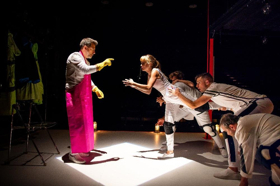Review: FRANKENSTEIN: Monster or Metaphor?

Frankenstein
Written by Nick Dear from the novel by Mary Shelley, Directed by David R. Gammons; Set Design, Cristina Todesco; Technical Design Consultant, Ben Leiberson; Costume Design, Rachel Padula; Lighting Design, Jeff Adelberg; Sound Design, David Wilson; Stage Manager, Renee E. Yancey; Assistant Stage Manager, Nicole Clark; Assistant Director, Manny Rosario; Dramaturg, Hilary Rappaport
CAST: Remo Airaldi, Omar Robinson, John Kuntz, Ashley Risteen, David Keohane, Debra Wise
Performances through November 4 by The Nora Theatre Company & Underground Railway Theater, in conjunction with Catalyst Collaborative@MIT, at Central Square Theater, 450 Massachusetts Avenue, Cambridge, MA; Box Office 617-576-9278 x1 or www.centralsquaretheater.org
The Central Square Theater, in conjunction with Catalyst Collaborative@MIT, has a corner on the market of blending art and science. It is no easy task to create intelligent, dramatic entertainment that can live up to their mission and put across its message with clarity, as well as artistry. However, when a group of serious artists comes together with purpose, the whole may be greater than the sum of its parts. Director David R. Gammons overlays his kaleidoscopic vision onto British playwright Nick Dear's adaptation of Frankenstein, from the novel by Mary Shelley, inviting the audience to conceive of a monster of their own imagination rather than the familiar cinematic versions.
Start with a stimulating suggestion of a creature of many diverse, moving parts. Add a brilliant, yet tormented scientist, both obsessed with his discovery and tempted by natural, human desires. Stir in the powerless bystanders who are damaged or doomed by their proximity to one or the other. Watch with increasing horror as the tale marches to its inevitable outcome. Finally, consider the many moral questions it raises about scientific responsibility, good vs. evil. acceptance or rejection of the "other," the definition of love, and what can happen when one man's self-aggrandizement challenges the concept and purview of God.
It may seem counterintuitive, but Dean's adaptation and the emotive performances of the ensemble combine to give us a somewhat sympathetic creature with a heart, a soul, and an intellect. Its heart may be childlike, its soul may be simplistic, but its intellect develops to the point of being able to successfully challenge its creator to get what it wants and needs. John Kuntz plays Victor Frankenstein, reveling in being the master of the man he built, until he learns the limits of his control. At times, Kuntz is also one of the many moving parts of the creature, tangled up with Remo Airaldi, David Keohane, Ashley Risteen, Omar Robinson, and Debra Wise, as they bring this amorphous body to life. All of the actors play additional roles, stepping away from the scrum to flesh out other characters in the story. As Delacey, a poor, blind man who doesn't fear what he can't see, Airaldi conveys a sweet, caring instructor who gets in touch with and brings out the creature's humanity. In contrast, he also plays M. Frankenstein, Victor's stern father, who rules the roost, yet also struggles to maintain control.
At various points in the play, each actor has the opportunity to take the lead of the group as creature. Robinson poignantly pleads the case for needing a female companion to slake his loneliness, to be accepted by someone, and to experience love. He exhibits such pain and longing, yet remains in control of himself to be more convincing to Victor. Robinson and Keohane team up as a pair of grave robbers, resigned to their task to provide the doctor with spare parts, and the latter captures the youthful curiosity of William Frankenstein. Wise and Risteen portray the female aspects of the creature, as well as the women of the Frankenstein family.
Wise conveys the burden of her role, the woman under the thumb of M. Frankenstein, trying to keep the peace between father and son, and offering some motherly guidance to Risteen's Elizabeth on the eve of her wedding to Victor. Elizabeth is an outspoken woman, unafraid to press Victor to learn about his work and get to the bottom of his reluctance to marry. Risteen finds her courage and intelligence, portraying her power without sacrificing her femininity. She also exhibits great physicality in her turn as the Female Creature.
Cristina Todesco's set design features a two-tiered cube of glass and steel that resembles an elevator shaft. The side walls are hinged and open to expose what goes on in the homes of Delacey and the Frankenstein family, and a ladder rises to the second level where Victor has his lab. The audience sits on two opposite sides of the stage, and the other two sides are lined with racks of costumes (Rachel Padula) for the actors to don when they play different characters. The ensemble is attired in white shirts and pants, with black pads strapped around their knees, for their scenes as the creature. Jeff Adelberg's lighting design and David Wilson's sound design effectively add to the haunting atmosphere, augmenting the audience's collective imagination.
Frankenstein opens with the creature's "birth," as it were, which Gammons stages with a great deal of writhing and nonverbal utterances by the ensemble. Although it lasts longer than I would consider to be optimal, it is effective to show the journey of the creature, from whence it came, through its phases of development, until it appears to reason like an authentic man. Despite the horrible acts he commits, the creature is intriguing because of his intelligence and his emerging humanity. The presence of actors with classical backgrounds infuses many of the speeches with a Shakespearean quality, enriching the dramatic gravitas. Crafting the play as an ensemble piece adds an entirely different dimension to an old, familiar story. Mary Shelley wrote her novel 200 years ago, and Gammons and company bring it into our time with a fresh perspective.
Photo credit: Nile Scott Studios (John Kuntz, Ashley Risteen, Debra Wise, David Keohane, Remo Airaldi)
Reader Reviews

Videos

